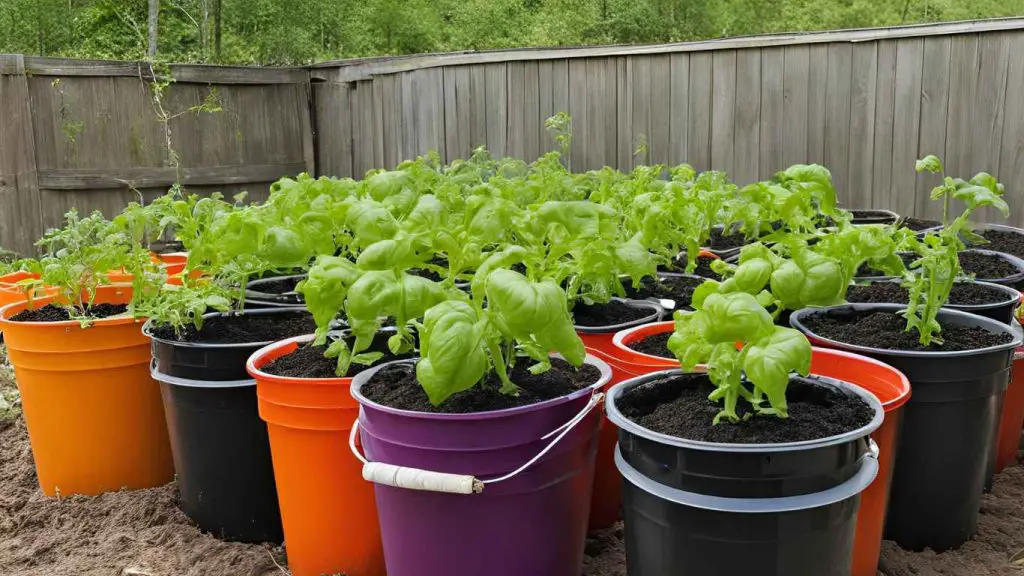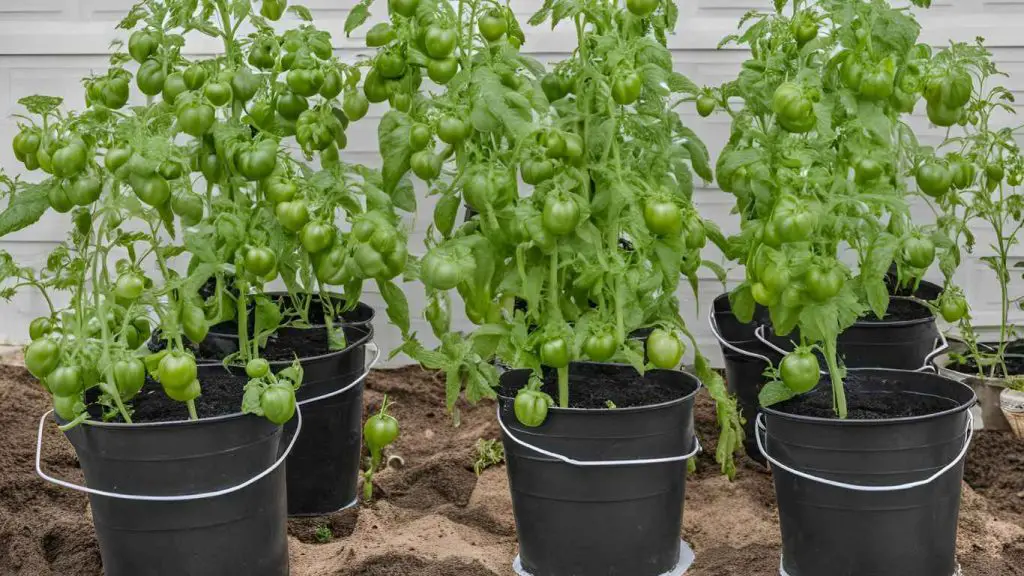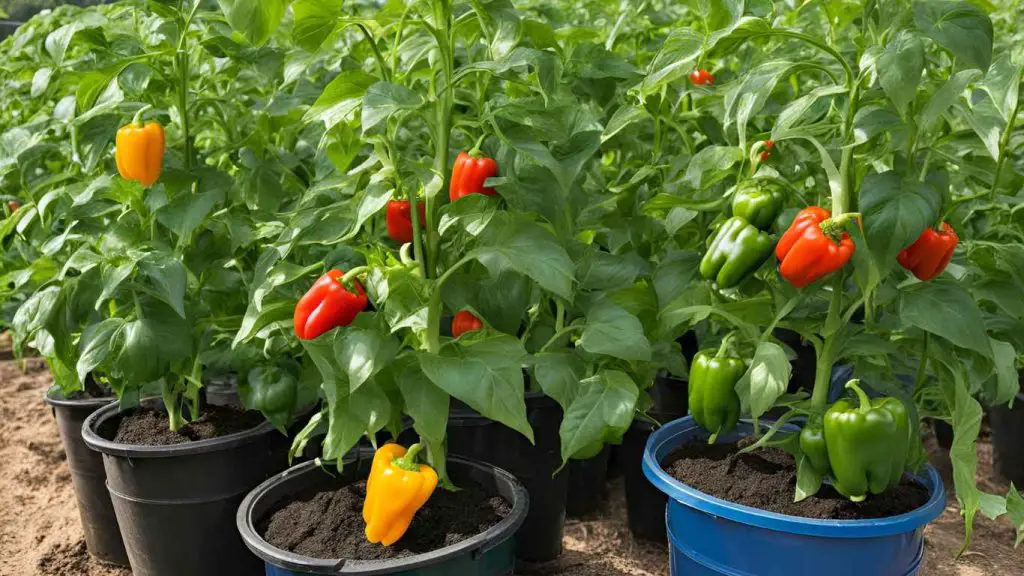Homegrown food is better for your health and your wallet in many ways. For example, the produce is fresher and more nutritious, and fewer pesticides are used.

If you don’t have a lot of space, container gardening, especially with buckets, is an easy and flexible way to grow plants. It gives you the most space, is portable, keeps pests away, manages the soil, and lets you grow plants all year long.
Bucket gardening uses 5-gallon containers filled with the right soil and compost, so plants can be grown all year, no matter what the weather is like outside. No matter how much you know about gardening, it’s a useful and enjoyable way to improve your diet and way of life.
Essential Supplies for Bucket Gardening
When you garden in a bucket, you need to choose the right size bucket, material, and soil mix for it. You can use 5-gallon buckets for herbs and small vegetables or bigger ones for plants that are bigger. For durability and insulation, you need materials like metal, plastic, ceramic, and clay.
For good drainage and nutrient retention, you need the right potting mix, compost, perlite, and coconut coir. Plants need to be fertilized regularly, and you can use organic, liquid, or granular fertilizers. Mulch, watering cans, drip irrigation systems, and self-watering buckets are all types of watering systems.
Other things you need for gardening, like shovels, hand pruners, plant labels, support structures, and pH meters, are drills for making drainage holes. With these things, you can make a bucket garden that grows well and gives you fresh, healthy food all year long.

1. Tomatoes
To grow tomatoes in small spaces, use buckets for determinate types like “Celebrity,” “Roma,” and “Bush Early Girl,” or patio or dwarf types like “Tiny Tim” and “Cherry Gold.” Container-specific types like “Balcony,” “Tumbler,” and “Micro-Tom” are designed for small spaces.
Fill a 5-gallon bucket with well-draining potting mix, place it in direct sunlight, water and fertilize regularly, support the plant with a stake or cage, prune, and monitor pests. Harvest the fruit when it is firm, fully colored, and has a little give.
2. Lettuce
Leaf lettuce varieties like Red Sails, Black-Seeded Simpson, and Butter Crunch thrive in small spaces, while Romani lettuce varieties like Little Gem and Parris Island Cos thrive in cooler temperatures. Muscling Mix, a mix of lettuce, arugula, and other salad greens, thrives in well-draining soil.
3. Carrots
Carrots thrive in buckets at least 12 inches deep, with depths of 16 to 20 inches. Avoid heavy clay soil and opt for light, sandy soil that drains well. Use homemade or store-bought potting mix for optimal soil preparation.
Remove trash and break it up to a depth of 12 inches, then add compost or coarse sand. Avoid using fresh manure as it can burn roots and spread weed seeds. Maintain a neutral pH between 6.0 and 6.8. Plant carrot seeds far apart, water gently, and cover with light mulch to prevent weed growth.
4. Radishes
Radishes can be grown in containers because they grow quickly, don’t take up much space, and don’t need much care. They have a lot of potassium, vitamins C and B6, and other important nutrients.
Pick pots with holes in them for drainage, use a potting mix that drains well, and plant seeds in soil that are loose and drain well. Put containers in full sun and water them often, especially during dry spells. Three to four weeks after planting, pick the radishes.
5. Onions
You can grow seeds by planting them in soil that drains well. It takes 7–14 days for the seeds to germinate, and you can harvest them after 6–8 weeks.
To make scraps, save the white bulb from store-bought green onions and plant it in soil or water. It will grow back in one to two weeks. Green onions keep growing as long as they are picked when they are 6 to 8 inches tall.
6. Kale
Kale comes in many types, such as dwarf blue curled, red Russian, and laminate, and can be grown in containers. These types are hardy, can grow in small spaces, and are very healthy, with lots of vitamins, antioxidants, anti-inflammatory compounds, fiber, calcium, and iron.
7. Strawberries
Hanging baskets, pots with pockets, and regular buckets and containers are all used for container gardening. Supports come in the form of raised stands. Self-pollinating, wind or hand pollination, and regular inspections are all parts of pest control and pollination.

8. Cucumbers
Vining cucumbers can be grown in buckets with the help of vertical trellises, cages, or stakes. Securely attach the trellis to the bucket so that the vines can grow up it.
Water the soil often, especially when plants are flowering or fruiting, and use a balanced, water-soluble fertilizer every two to three weeks. For long-term nutrition, add compost to the soil.
9. Spinach
To grow spinach in a container, you need to choose the right container, prepare the soil, and plant the spinach. For fertile soil, use potting mix that drains well and compost. Plant spinach seeds in pots, leaving about 2 to 3 inches between each one.
Water them gently. Put pots where they will get full sun to some shade. You can use the cut-and-come-again or full harvest methods to harvest spinach 4 to 6 weeks after planting it.
Take care of common problems like bolting, pests, diseases, poor germination, and not getting enough nutrients. If you follow these steps, you can grow spinach plants in pots that are healthy.
10. Basil
Basil grows well with tomatoes, peppers, oregano, and other herbs in containers. It keeps pests like aphids and whiteflies away. It makes nearby vegetables taste better and helps them grow in a healthy way.
Regular pinching and pruning make the plants grow bushier, and frequent harvesting keep them from getting leggy.
11. Cilantro
Cilantro grows best in organic matter-rich soil that drains well and has a balance of potting mix and compost. Daily full sun for 6 to 8 hours, with some afternoon shade in hot places.
Plant in cooler months and give them some shade to keep them from bolting. Neem oil or insecticidal soap can help you get rid of pests like aphids and fungal diseases.

13. Parsley
Plant parsley 1/4 inch deep and 6 to 8 inches apart. To harvest, cut the outer stems off at the base and tie them up often to encourage new growth and keep them from getting too bushy.
14. Mint
Due to its aggressive nature, mint does best when grown in containers so it doesn’t get too big. It’s used in cooking to give salads and drinks like teas and cocktails a fresh taste.
15. Potatoes
To get more potatoes, dig a shallow trench and plant seed potatoes in it. Add three to four inches of soil and water well. Put more soil around the stems as the plants grow. Put soil or straw around the stems in a mound. Pick potatoes two to three weeks after they bloom, or wait until the leaves fall off.
16. Eggplants
For better airflow and bushier growth, support eggplants like “Black Beauty,” “Ichiban,” “Fairy Tale,” and “Rosa Bianca” with stakes or tomato cages. Remove suckers and extra leaves when pruning.
17. Zucchini
Some types of zucchini, like “Eight Ball,” “Bush Baby,” “Patio Star,” and “Ford hook Zucchini,” need to be pollinated by hand with a brush and nearby flowers like marigolds and zinnias.
18. Peas
For cooler climates, plant peas in early spring or fall. Wando or Alaska are good varieties to choose from. Use nets, trellises, or bamboo stakes to support climbing plants and make sure they are pointing in the right direction.

19. Chard
Chard comes in many types, such as Bright Lights, Ford hook Giant, and Ruby Red. Cut back often to encourage new growth and extend the harvesting season, and pick the outer leaves first.
20. Broccoli
Calabrese, Di Cisco, and Sun King are all compact broccoli varieties that do well in small spaces and are easy to care for. They need to be watered often, fed with good fertilizer, and covered with mulch to keep weeds away.
21. Peppers,
Growing bell peppers, chili peppers, and sweet peppers in containers is called container gardening. They need full sun—six to eight hours of direct sunlight every day—and soil that is moist.
Tie plants that are taller up with stakes or cages, and give them a balanced fertilizer every two to three weeks. Peppers do best when it’s warm, between 70°F and 85°F. Keep them away from cold drafts and frost, though.
21. Cauliflower
For cauliflower with white heads, some tips are to cover the heads with leaves or cloth, use varieties like snowball, graffiti, and Romanesco, use natural remedies like neem oil and insecticidal soap to get rid of pests and follow cultural practices.
22. Cabbage
Cabbage compact varieties that do well in containers grow faster, and need well-drained soil, balanced fertilizers, regular watering, and a pH level that is slightly acidic to neutral. They are good for Savoy Express and containers.
23. Brussels sprouts
Brussels sprouts need a long growing season—80 to 100 days from transplanting—colder temperatures—planting in late summer for a fall harvest—stakes or cages for support—and they need to be tied up and have their leaves removed often to let more airflow.
24. Herbal Teas (Mint, Lemon Balm, etc.)
This is a great way to store herbal teas like mint, lemon balm, chamomile, and lemon verbena. Herbs should be picked and dried in the morning using a dehydrator, air drying, or a low-heat oven. Use airtight containers to store.
25. Garlic
If you take big, healthy cloves from a bulb, you can grow garlic from them. Plant it 2-3 inches deep and 6 inches apart in well-drained soil with a pH between 6.0 and 7.0 in the fall.
If you cure garlic the right way, it can last for months. Lower leaves turn yellow and dry in the middle of summer, which is harvest time. Cut back the stems and trim the roots after it’s been cured. Then, store it somewhere cool, dry, and with good airflow.
